Strong I (DD-467)
1942–1943
The first Strong was named in honor of James H. Strong, born in Canandaigua, N.Y., on 26 April 1814. Strong began his service with the U.S. Navy while enrolled at the Polytechnic College, Chittenango, N.Y. During his time at Polytechnic he was appointed midshipman on 2 February 1829, and with special permission from the Secretary of the Navy he remained at that school until his graduation in 1833.
Strong’s first assignment in 1833 was with the Brazil Squadron where he served on board the sloop Lexington and then later the schooner Enterprise in 1834. While serving in Lexington, Strong led a daring expedition against a band of pirates based in the Falkland Islands. Despite being heavily outnumbered, Midshipman Strong and his men executed an expert attack and effectively surprised the pirate encampment. The swashbucklers managed to fire at the American sailors only a single time before they were brought to close quarters in hand to hand combat. In the end, Strong and his crew carried the day, recovering several formerly captured vessels and freeing numerous prisoners. The surviving buccaneers were delivered to the Argentine Government at Buenos Aires for trial.
Following his exploits with the Brazil Squadron, Strong returned stateside in 1835 and attended the Naval School in N.Y. Upon the completion of his studies at the Naval School, Strong shipped out in the frigate Constellation, where he assigned to the West India Squadron. On 4 June 1836, he was promoted to passed midshipman. From 1839 to 1842 he served with the razee Independence, operating with the Brazil Squadron. In September 1841, while still on board Independence, he was commissioned as a lieutenant. He later sailed in the frigate Columbus, assigned to the East India Squadron from 1844 to 1846.
Strong married Ms. Marie L. Von Covenhoven, a native of Long Island, N.Y., in 1844, a union that produced two children, Maria Louisa and William Covenhoven. William followed in his father’s footsteps and also served in the U.S. Navy.
From 1851 to 1852, Strong served on board the Receiving Ship at Brooklyn, N.Y. He ventured back out to sea with the sloop Levant, assigned to the Mediterranean Squadron, from 1853 to 1855. In 1856 he found himself back with the Receiving Ship in N.Y. He assumed his first command in 1859 with his assignment to the store-ship Relief. Just a few weeks after the outbreak of the American Civil War (1861-1865), Strong was promoted to the rank of commander on 24 April 1861, and assumed command of the steamer Mohawk, assigned to the South Atlantic Squadron.
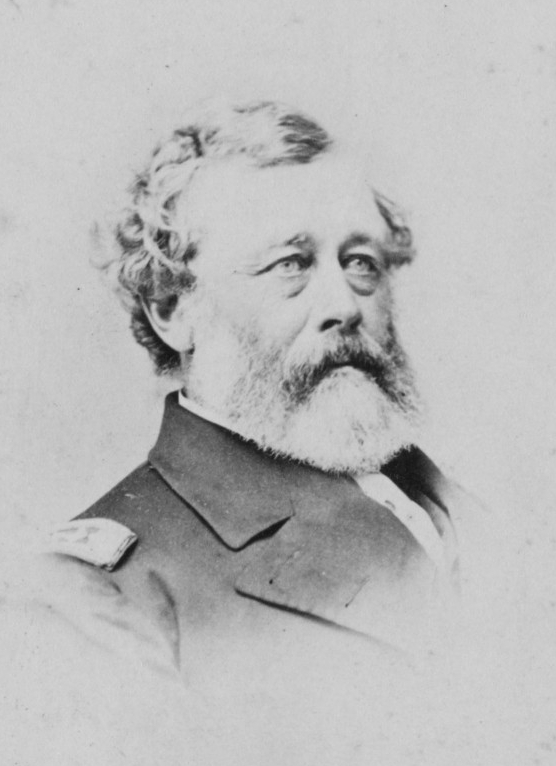
In support of Operation Anaconda, a military strategy devised by U.S. Army General Winfield Scott to cut off the Confederacy’s access to the sea, Strong commanded the steam-sloop Monongahela from 1863 to 1865, as part of the Western Gulf Blockading Squadron. In November 1863, Cmdr. Strong steamed Monongahela from New Orleans to the Brazos Islands, Brazos de Santiago, as part of a troop transport convoy. On 25 November, he assisted the soldiers in the convoy, under the command of Maj. Gen. Nathaniel P. Banks (1816-1894), in performing an amphibious landing as well as a subsequent bombardment that resulted in the capture of “a battery of three heavy guns at Aransas Pass.” Strong again demonstrated his capabilities as a naval commander during the Battle of Mobile Bay on 5 August 1864. In the heat of that encounter, Strong steered Monongahela out of the line of battle to engage the rebel ironclad Tennessee, “and struck her fair, at the same time giving her a broadside of solid 11-inch shot.” Seemingly still in the fight, Strong prepared Monongahela to run at her again before Tennessee finally surrendered.
On 5 August 1865, just a few months after the end of the Civil War, Strong was promoted to captain. With the ending of hostilities, he was sent to the New York Navy Yard, Brooklyn, N.Y., where he served as an Inspector from 1866 to 1867. Following his stint ashore, Strong returned to sea from 1868 to 1869, commanding the steam-sloop Canandaigua, assigned to the European Squadron. On 21 March 1870, he was promoted to the rank of commodore and shortly thereafter he served for two years as a Lighthouse Inspector for the Third Naval District. In September, 1873, he was again promoted, this time to the rank of Rear Admiral. It was in that same year that he assumed command of Lancaster, and served as the Commander-in-Chief of the South Atlantic Squadron.
Strong remained in that position until his official retirement from the U.S. Navy on 25 April 1876—at which time he had completed more than 48 years of service. He died in Columbia, S.C., on 28 November 1882.
I
(DD-463: displacement 2,050; length 376'6"; beam 39'4"; draft 13'5"; speed 35.5 knots; complement 273; armament 5 5-inch, 4 40 millimeter, 4 20 millimeter, 2 depth charge tracks, 6 depth charge projectors, 10 21-inch torpedo tubes; class Fletcher)
The first Strong (DD-467) was laid down on 30 April 1941 at Bath, Maine, by Bath Iron Works, launched on 17 May 1942, sponsored by Mrs. Susan H. Olsen, the great-grandniece of Rear Adm. James H. Strong, and commissioned at the Boston [Mass.] Navy Yard on 7 August 1942, Cmdr. Joseph H. Wellings in command.

Following her commissioning, Strong remained at the Boston Navy Yard until 31 August 1942, to complete her fitting out and final alterations. On 1 September, she put out to sea for the first time and reported to the Commander-in-Chief, U.S. Atlantic Fleet, for her shakedown. The first leg of her shakedown consisted of a cruise to Newport, R. I., via the Cape Cod Canal, where she picked up her first torpedoes on 2 September. After test firing the torpedoes, the destroyer departed Newport at 0700 on 4 September, and headed for Casco Bay, Maine, where she arrived at 1800 that same day.
Strong conducted the majority of her shakedown in the Casco Bay area. From 11 to 13 September 1942, Strong, along with Radford (DD-446), screened the battleship Massachusetts (BB-59) as she traveled to Boston. After completing her escort mission Strong returned to Casco Bay. Only a few weeks later, from 22-23 September, she again served as a screen for Massachusetts, along with Rodman (DD-456) and Emmons (DD-457), while operating in the Gulf of Maine—during which time she also patrolled for enemy submarines. Strong departed Casco Bay at 0730 on 28 September, and arrived at the Boston Navy Yard at 1630. Once in port she remained there for a seven-day availability period. On 6 October, the destroyer left Boston at 0940, and set a course for Seal Island, Gulf of Maine, where she engaged in a brief shore bombardment exercise. Her shakedown officially ended on 7 October, and she departed the Casco Bay area at 1700. At 1917, Strong joined the oiler Mattaponi (AO-41) and escorted her to Naval Operating Base (NOB) Hampton Roads, Virginia.
After she completed her escort duties with Mattaponi on 9 October 1942, Strong docked and re-fueled at Norfolk. The next morning she was underway by 0600, along with LaVallette (DD-448), escorting transport [converted submarine tender] Antaeus (AG-67) and provision storeship Ariel (AF-22) to San Juan, Puerto Rico. The convoy entered San Juan Harbor on 13 October and Strong moored at the North Pier to take on fuel. At 0617, the next day, Strong departed San Juan in order to escort Ariel to St. Thomas, V.I. Strong and her charge arrived in Charlotte Amalie Harbor at 1235. The destroyer moored alongside La Vallette at the West Indian Company Pier. She remained in the area with La Vallette for several days and the two of them conducted patrols in the vicinity of St. Thomas.
On 17 October 1942, Strong in company with LaVallette, and Ariel got underway from St. Thomas, and set a course for San Juan. On 18 October, she accompanied LaVallette and Antaeus from San Juan to Port of Spain, Trinidad. At 0630, on 19 October, she arrived at Boca De Navios and patrolled the area with LaVallette before mooring at Pier 1. At 1345 the next day she again put out to sea in company with LaVallette and met Antaeus and the U.S. Army transport [USAT] State of Maryland, charting a course for San Juan. The convoy arrived on 21 October, at 1318, and Strong moored at Pier 1.
Strong departed San Juan on 24 October 1942, along with LaVallette, Antaeus, and Ariel, heading for Norfolk. The convoy reached its destination without incident on 27 October, and moored in the navy yard. Strong remained there until 29 October, when she set out for New York City in the company with Chicopee (AO-34) and minelayer Terror (CM-5), and LaVallette and Saufley (DD-465). She arrived at the New York Navy Yard at 1400 on 30 October, and remained in port for a five-day availability.
Strong set out from New York on 13 November 1942, as a part of convoy UGS-2 steering a course for North Africa. She arrived at Casablanca without incident on 29 November, and then returned to N.Y. as a part of convoy GUF-2. The destroyer experienced some mechanical problems and as a result remained at the New York Navy Yard until 22 December.
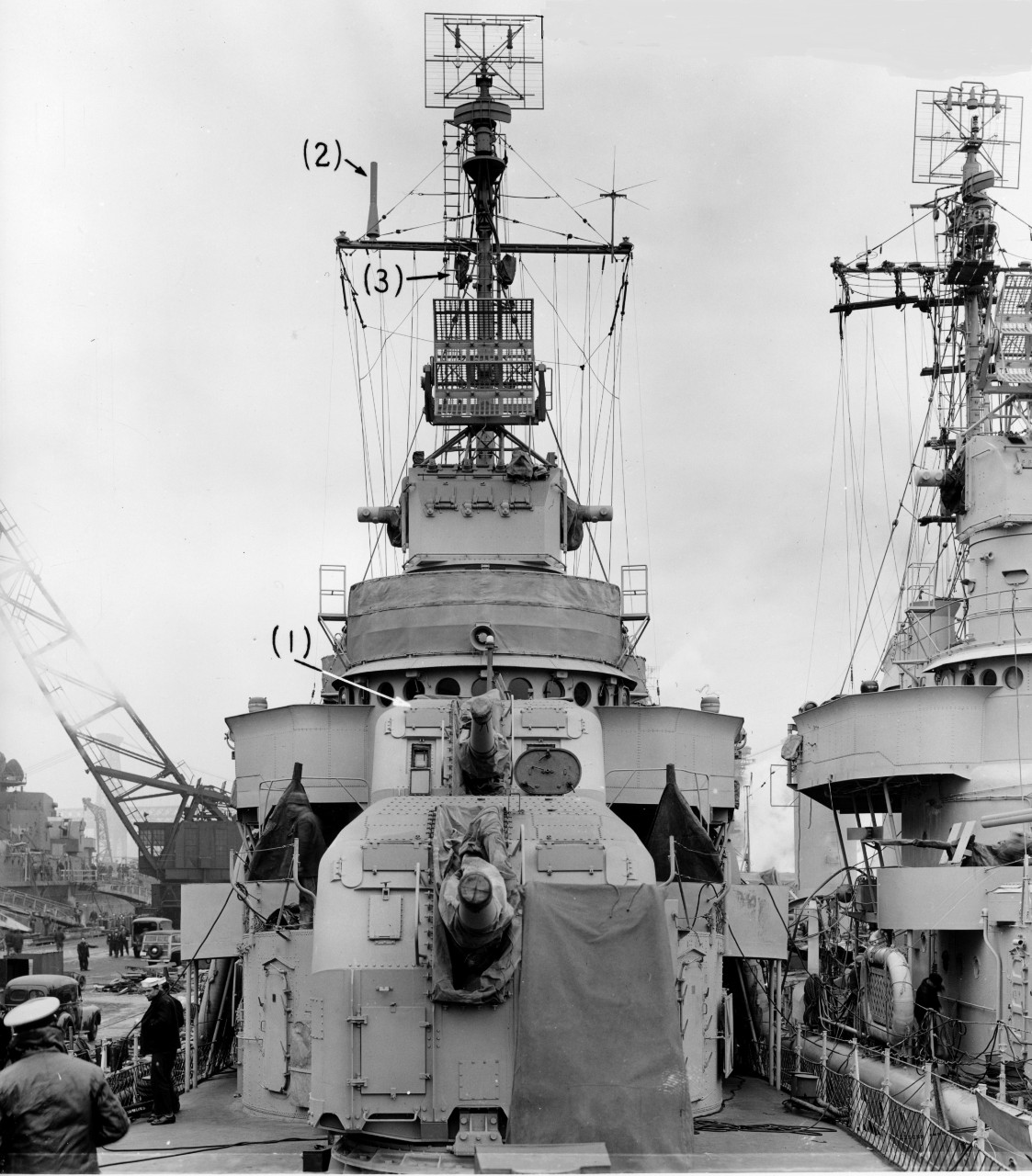
Following the conclusion of her repairs, Strong conducted post overhaul trials at Long Island Sound on 23 December 1942—her engineers still detecting small amounts of oil in the machinery but the issue was deemed to be only minor—and her commanding officer reported her ready for duty. On 25 December, the destroyer cast off from the 33rd Street Pier in Brooklyn and set course for Norfolk, in company with Rodman, and Emmons, the destroyers formed an anti-submarine screen for the transport Monticello (AP-61). Strong arrived in Norfolk at 1301, and moored to the south side of Pier 5.
Two days after her arrival at Norfolk, Strong was again underway, sailing as part of Task Force (TF) 39—to perform escort duty for a convoy headed for Nouméa, New Caledonia. Only a few days into the voyage, Lt. Henry P. Laughlin, MC, the ship’s medical officer, performed an emergency appendectomy on an enlisted sailor, an event which required not only the skill of the doctor but also that of the ship’s navigator, who had to maintain the destroyer’s zigzag pattern while also attempting to keep the vessel as stable as possible. Strong continued on her 11,000 mile course through the New Year, which is often commemorated in the ship’s mid watch deck log with a befitting poem, authored by Lt. James A. Curran, who had been vice president of his graduating class at the Naval Academy and known for being “always good for a ready pun or a riot in the corridors” of Bancroft Hall: “Somewhere in the cities the whistles are screaming, but here in the Strong we are, as usual, steaming.”
The destroyer reached the Panama Canal on 2 January 1943, and at 1255, in company with her task force she entered the Gatun Locks and departed the Caribbean in a single column. Upon reaching the waters of the Pacific, Strong moored alongside Cony (DD-508) at Pier 16, Balboa, C.Z. From 3 to 5 January, she was repainted for her coming operations in the Pacific. She departed Balboa at 0737, on 6 January, and conducted an anti-submarine patrol with Warrington (DD-383) and Cony; during that time she was briefly forced to undergo some minor repairs at sea. She reported that she was fully operational again on 7 January, and she swiftly rejoined TF 19. On 13 January, Strong crossed the equator and in adherence to tradition she conducted a crossing the line ceremony “in accordance with wartime operations.”
“Underway as before,” Strong was well into her voyage in the Pacific on 16 January 1943, with a new crew of “shellbacks” to boot, when transport Joseph T. Dickman (AP-13) sighted a ship on her starboard side. The vessel later proved to be Patuxent (AO-44) however, planes from the light cruiser Concord (CL-10) were in the air at the time and failed to report the vessel before Joseph T. Dickman did. The Task Force Commander proved immensely distressed that Concord’s aircraft had not sighted the ship and he reported that “disciplinary action would be taken.”
The next day [17 January 1943] proved no less eventful, for at 2245, three of his shipmates nearby evidently ignorant of his suicidal intent, Sea1c Leonard R. Colvin, one of Strong’s plankowners, “suddenly remove[d] his shirt and trousers and then deliberately jump[ed] over the side of the ship about 50 feet forward of the starboard propeller.” The ship’s engines were stopped and Strong immediately turned to port. She circled the area in an effort to search for the man—but his body was not recovered, and he was determined to be lost to the sea. According to the ship’s log the Secretary of the Navy was promptly notified of the incident.
Strong parted company with the task force on 18 January 1943, and steamed to Bora Bora, Society Islands, for fuel. She made port on 19 January, and there embarked Lt. Col. Edward N. Fay, QMC, U.S. Army, as a passenger, and then later that day rejoined the task force. She continued her voyage and on 27 January, reached Nouméa and moored alongside Pasig (AO-89) in berth 52, where she disembarked Lt. Col. Fay the next day.
On 28 January 1943, at 1515, Strong left Nouméa via the Bulari Pass in company with Cony, attack transport Thomas Jefferson (APA-30), Joseph T. Dickman, and Hermitage (AP-54), as part of TF 66.19. On 30 January, Selfridge (DD-357) and Henley (DD-391) relieved Strong and Cony, the latter destroyers setting course to return to Nouméa, where they arrived at 1612 on 31 January, and moored in the inner harbor of Dumbea Bay.
After re-provisioning on 1 February 1943, Strong and Cony departed Nouméa as a part of Task Group 66.19, escorting Biddle (DD-151) and the attack cargo ship Oberon (AKA-14) and proceeding to Espiritu Santo, New Hebrides. They arrived at Espiritu Santo at 0930, and Strong moored to the port side of Platte (AO-24) and re-fueled. On 4 February, she received 40-millimeter ammunition from destroyer tender Dixie (AD-14). The next day Strong formed TG 62.9 with American Legion (APA-17) and Hunter Liggett (APA-14), and Patuxent, and proceeded to Guadalcanal. On 7 February, Strong led the formation through the Sealark Channel between Guadalcanal and the Florida Islands. At 1745, Strong and her task group received an order from the Commander, South Pacific Force, to clear the area in anticipation of the arrival of the “Tokyo Express,” a force of 20 Japanese destroyers that were making regular trips south to deliver supplies and evacuate Japanese troops from Cape Esperance. On 8 February, Strong was cleared to continue on to Guadalcanal.
The destroyer arrived at its destination at Guadalcanal at 1115 on 9 February 1943. As transports worked cargo, Strong, and the other escorts conducted patrols in the area. The next day, Strong performed anti-submarine patrols and screened Patuxent, as she unloaded aviation gasoline inshore at Guadalcanal. At approximately 2100, Strong was given the “good news,” that the U.S. Army had gained control of Guadalcanal Island. She departed Guadalcanal at 0605 on 11 February, in company with Humphreys (DD-236), to escort Patuxent. On 13 February, she was ordered to break off from the convoy and headed out to join TF 67, which consisted of light cruisers Nashville (CL-43), Helena (CL-50), Honolulu (CL-48) and St. Louis (CL-49), along with Jenkins (DD-447), Chevalier (DD-451), and Taylor (DD-468). The force made port at Espiritu Santo at 0645, on 14 February, and Strong moored to the port side of Chevalier in Berth 24. Once set, she took on fresh stores and oil, then was again underway on 15 February with the task force.
“Steaming as before,” on 17 February 1943, at 1050, the force sighted a submarine periscope. Chevalier broke formation to attack and subsequently dropped 41 depth charges—but ultimately, found no signs of enemy damage and the force pressed on. Strong moored in Segond Channel, Espiritu Santo, on 23 February. On 3 March, Strong’s boilers were fired up and she went on the first of many patrols in the vicinity of the Solomons. She was underway on 3 March, from Segond Channel with TF 67, Rear Adm. Walden L. Ainsworth (Honolulu, flag) in command. At 1735, on 9 March, the formation had to make a 90° emergency turn after Chevalier spotted a submarine—but nothing came of it. Strong briefly left the force on 12 March in order to take on fuel at Espiritu Santo, but shortly thereafter rejoined. Strong refueled at Tulagi Harbor on 15 March.
On 16 March 1943, Strong, Nicholas (DD-449), Radford, and Taylor—as part of TG 18.6, steamed to Kolombangara Island to shell Japanese shore installations located at the Vila Stanmore coconut plantation. At 2400, the crew went to general quarters and at 0203, Strong followed the column leader, Nicholas, in bombarding Vila-Stanmore. After only 11 minutes of firing, Strong and the others in the task group broke off their attack and Strong “poured on the oil,” to clear Kula Gulf post haste. Strong and the rest of the task group then resumed their patrol duties in the Solomons.
In company with TF 18.6, on 19 March 1943, Strong passed northeast of San Cristobal in the Galapagos archipelago. From there the task force was ordered to proceed to the Guadalcanal area and to steam on a northwesterly course between New Georgia and Santa Isabel; they were on a search and destroy mission with the directive of targeting Japanese shipping bound for Vial Island [Wei Island] and Munda, New Georgia. No enemy ships were encountered and Strong resumed her patrolling in the area of the Solomons—she entered Espiritu Santo harbor on 22 March. The destroyer remained moored at Espiritu Santo until 25 March, at which time she began a series of patrols in the immediate area. On 29 March, at 0817, Strong, in company with TF 18.6, departed the Espiritu Santo area and set a course for Tulagi. She arrived there without incident on 1 April, and in accordance with the task force directive she conducted patrols in the area.
O’Bannon (DD-450) was on a patrol with Strong in the early morning hours of 5 April 1943, when the ships made surface radar contact with an unknown vessel. At 0210, the crew went to general quarters. O’Bannon investigated, and fired a salvo from its main battery reportedly destroying a surfaced enemy submarine. Just a few days later, on 7 April, Strong’s crew again went to general quarters for a possible air raid on the Tulagi area of Guadalcanal, but no attack developed. While steaming later that night, at 2152, Strong established radar contact and again went to general quarters. Strong’s searchlight revealed the presence of what proved to be RO-34 (Lt. Cmdr. Tomita Rikichi). Strong opened fire with her main battery and machine guns -- expending ten 5-inch/38 rounds, 98 40-millimeter rounds, and 288 20-millimeter rounds. The destroyer reported that she struck the submarine three times with her 5-inch fire. During the barrage, RO-34 dove into the sea, down by the stern.
Strong circled RO-34’s location and dropped ten Mk. 6 depth charges and six Mk. 7 depth charges, to ensure RO-34’s journey to the bottom. Before she returned to the task force, Strong observed debris from RO-34 on the surface at 10°05'S, 162°08'E, and she was later credited with the sinking. After the war Japanese records indicated that RO-34 was given orders on 16 April to return to Rabaul, New Britain, which went unanswered, leading to the presumption that she was lost with all 66 souls on board.
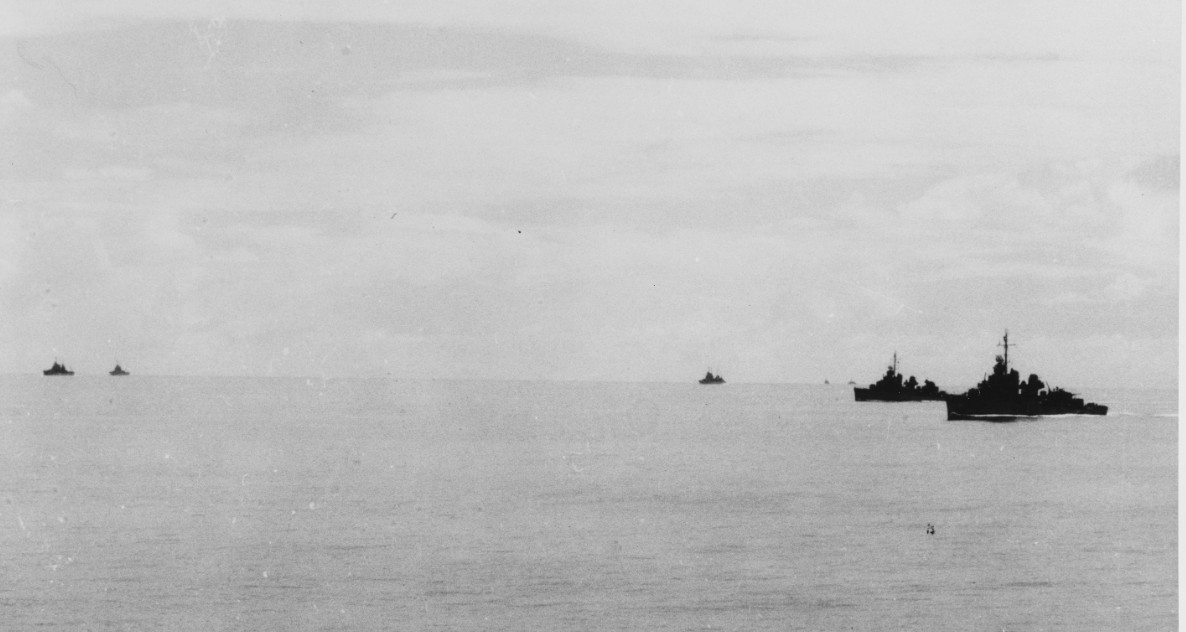
While moored at Espiritu Santo Harbor, on 10 April 1943, Strong replenished Mk. 6 and Mk. 7 depth charges from Dixie. Strong remained moored at the harbor, conducting occasional patrols in the outlying area until 5 May, when she finally departed Espiritu Santo in the early morning hours, at 0447, and set course for Segond Channel. En route with TF 18, Strong covered the mining operations conducted in the Blackett Strait, between Kolombangara and Arundel Island, by the light minelayers Gamble (DM-15), Preble (DM-20) and Breese (DM-18). A group of four Japanese destroyers later steamed into the minefield and Kuroshio was sunk outright; Oyashio and Kagero were damaged, but soon destroyed by dive bombers forthwith; a fourth Japanese destroyer, Michisio, was damaged by the U.S. planes. The next day, on 8 May, Strong arrived int port, along with Honolulu, O’Bannon, St. Louis, Nashville, and Chevalier. The destroyer was drydocked on 9 May, at 1930, to undergo repairs for a damaged plate. Following her repairs, she departed Espiritu Santo on 12 May, as part of TF 18 (Rear Adm. Ainsworth) to bombard enemy shore installations in the Solomons.
A little over an hour into the mid watch, at 0101 on 13 May 1943, Strong, in company with her task force, commenced firing at enemy shore establishments located at Kolombangara, Enogai Inlet, and Rice Anchorage—in total expending 807 rounds of 5-inch/38 ammunition. After breaking off from the attack and returning to formation Strong had a brief scare when she established radar contact with an unknown plane. She fired five 5-inch projectiles at the plane and fortunately did not hit it—as she soon thereafter identified the aircraft as friendly—she ceased fire and steamed on. At 1630, on 14 May, she moored alongside O’Bannon at Espiritu Santo, where she remained until 19 May, when she set out to join Task Unit (TU) 32.4.6. After joining the task unit, she steamed to Guadalcanal to perform patrol duties, primarily screening merchantmen, and performing antisubmarine patrols.
On 23 May 1943, at 1545, Strong received verbal orders from Commander, TF 18, to break off patrol and proceed to the assistance of the motor torpedo boat tender Niagara (AGP-1) and six U.S. motor torpedo [PT] boats reportedly burning. Strong’s crew “poured on the oil,” and rushed to Niagara’s last known location, the tender having been hit in a Japanese horizontal bombing attack. Well into the day on 24 May, Strong and Wilson (DD-408) continued the search for Niagara however, at 0351 they were called off, after receiving word that the survivors were safe, although Niagara’s damage had proved mortal and she had had to be scuttled by PT-147. Strong promptly returned to her patrol duties, which she executed into mid-June.
As a part of TU 32.4.5, Strong, Monongahela (A0-42), and Nicholas (DD-449) were underway from Tulagi at 1330 on 16 June 1943. At 1413, while steaming halfway between Tulagi and Lunga Point, the task unit caught sight of enemy planes bombing ships between Lunga and Kili Point. Within moments, 15 Aichi D3A Type 99 carrier bombers [Val] roared into view bearing straight for them on a northwesterly course and maintaining a shallow glide at an altitude of approximately 100 to 500 feet. In short order those planes were joined by six additional bombers and Mitsubishi A6M Type carrier fighters (Zekes). Strong found herself in proximity to the enemy planes and took full advantage of her position—her guns fired 194 rounds of 5-inch, 750 rounds of 40-millimeter, and 980 rounds of 20-millimeter. As a result of the barrage she managed to “splash three of them.” The surviving planes disappeared into the horizon but “dog fights” could still be observed in the skies above Savo Island. The ship’s log noted that Lt. James A. Curran, Strong’s gunnery officer, performed commendably during the action. Strong and the task unit returned to Tulagi at 1518.
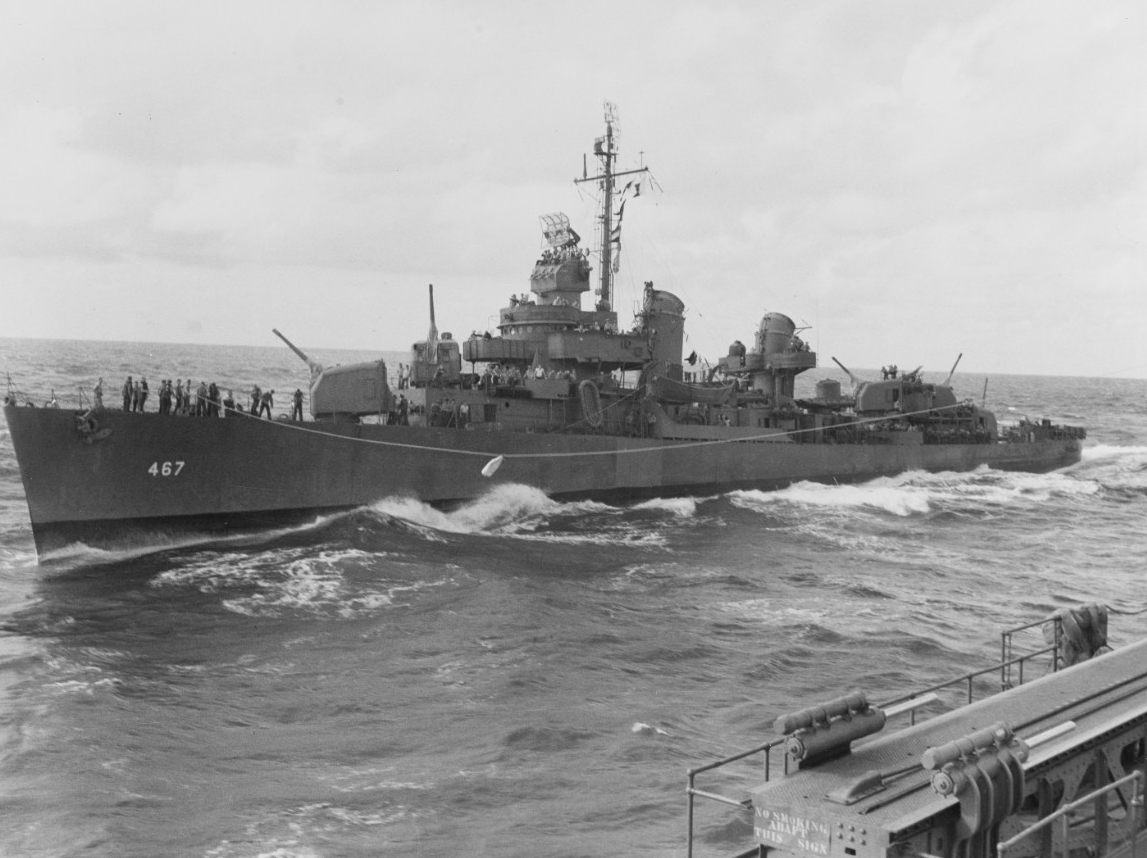
Strong’s final act in the war in the Pacific occurred in the clear, dark early morning hours of 5 July 1943. American forces were landing at Rice Anchorage and in support of those landings Strong steamed from the Tulagi area with TF 18, which included Honolulu, Helena, St. Louis, and O’Bannon. They were headed for Kula Gulf to shell Japanese shore installations at Vila-Stanmore, Enogai, and Bairoko. Strong and Nicholas entered Bairoko Harbor and opened fire on the enemy from 0030 to 0040. Only minutes after her guns went silent, however, Strong’s gunnery officer observed a torpedo wake and she was struck on her port side near the after end of the number one fireroom. Lt. Donald A. Regan, D-V(G), recalled that when the torpedo hit, it “knocked me off my feet.”
When Strong was struck by the torpedo from the spread fired by Japanese destroyers Niizuki (flagship of Rear Adm. Akiyama Teruo), Yunagi, and Nagatsuki, Honolulu was steaming1,000 yards astern of her, with Helena and St. Louis 1,000 yards astern of Honolulu; and O’Bannon and Chevalier astern of St. Louis. Prior to and following the torpedo strike neither Strong, nor any of the other ships in the force detected any enemy surface vessels or submarines, a testimony to the incredible range of the Japanese torpedoes.
Within five minutes of the torpedo exploding on her port side, Strong had still not gone under and listed only 15 to 20 degrees. The other destroyers in the task group quickly moved to assist the doomed destroyer. Immediately, O’Bannon began firing on enemy shore batteries (140-millimeter guns) located at Enogai Inlet that were targeting the area with their main batteries, as well as with star shells to illuminate the area. Chevalier, Cmdr. Ephraim R. McLean Jr., commanding, in a display of superb seamanship, rammed Strong’s bow so that nets and lines could be employed to expedite rescue operations. With Chevalier’s arrival alongside, the order to abandon ship came soon thereafter.
In approximately seven minutes, 234 enlisted men and seven officers, about 75% of the ship’s company, made it across the nets and onto Chevalier, “in confined enemy waters two miles from enemy positions.” Shore battery fire began to splash in the vicinity, however, and lest Chevalier also be sunk, Cmdr. “Mac” McLean, her commanding officer and in the class that graduated from the Naval Academy a year ahead of Strong’s CO, suspended the rescue operations and cast off. Cmdr. McLean was later awarded the Navy Cross for his efforts to save the survivors of Strong, having initiated the rescue “despite hazardous conditions, enemy submarines, hostile enemy bases and explosions which damaged his own ship.”
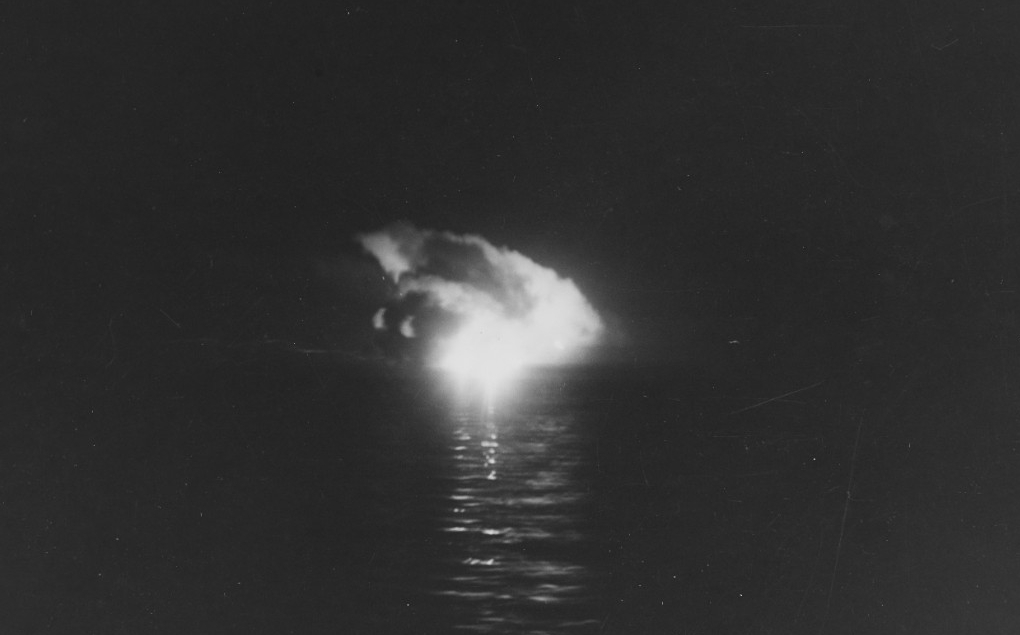
Following Chevalier’s departure Strong continued to settle with a 40° to 60° list on her starboard side. As she sank she broke in half, her after end twisting to starboard approximately 40 degrees. Lt. Hugh B. Miller later recounted he “got the impression that as the ship sank it broke in two at the point where the torpedo had hit us.” To add to the chaos, as Strong was being swallowed by the sea, her 300 pound depth charges stored at the K-guns on her starboard side, aft, exploded, putting Chevalier’s radars and sound gear out of commission.
Many, including Cmdr. Wellings and CQM Maurice A. Rodrigos, plankowners, did not make it onto Chevalier. After Strong was hit the ship’s life rafts landed bottom side up with the equipment on the bottom side of the rafts—making it very difficult to get to, a circumstance compounded by the darkness. Many were trapped below decks, in fact, 21 enlisted men and the engineer officer were trapped in the no.1 fireroom and engine room.
Lt. Regan heard the sound of tapping on the main deck, directly above the flooded no. 1 engine room. Looking down the emergency hatch, he saw EM2c Willard G. Langley, USNR, a plankowner, who had been badly wounded, balanced precariously atop the switchboard with the water rising just beneath him. The 27-year old Bostonian lowered himself through the hatch and gained secure footing on the braces for the switchboard, then assisted Langley up through the hatch, where other men pulled the wounded sailor through and lowered him to a raft.
Despite having been ordered to abandon ship, 24-year old Lt. Benjamin F. Jetton, D-V(G), the communications officer, and 24-year old Ens. William C. Hedrick, Jr., D-V(G), his assistant, a former high school teacher, “insisted on remaining below decks in the officer’s country passageway, removing secret and confidential publications and placing them in weighted bags and throwing them over the side…” They were continuing their conscientious performance of duty “when the ship went down.” Both men, graduates of the U.S. Naval Reserve Midshipmen’s School, Northwestern University, were awarded, posthumously, the Silver Star.
Lt. Cmdr. Frederick W. Purdy, Strong’s executive officer, remained on board during the evacuation to Chevalier and intentionally stayed behind after Chevalier shoved off to investigate a report of a wounded enlisted man on the deck behind Mt. 52. Purdy’s body was later found on the beach at Arundel Island—he was posthumously awarded the Silver Star. In total, 46 brave sailors went down with Strong.
As Chevalier backed away from her doomed sister ship, Lt. Regan was pulled off Strong’s forecastle into the water. After swimming around for about five minutes, he came across Strong’s gig that had been lowered prior to the ship going down, and clambered in, taking charge of it, and “remained in the area for a considerable time,” rescuing 17 of his shipmates. Unable to locate other rafts or survivors, Regan set course out of Kula Gulf, proceeding beyond Visu-Visu Point, heading for Guadalcanal, knowing that a group of APDs and destroyers was to clear Kula Gulf by 0600. After daylight, Ralph Talbot (DD-390) rescued the gig’s occupants.
In his final report, Cmdr. Wellings later said of it “the loss of these splendid men and officers is seriously regretted.” Wellings’ own life was saved due to the courage of CQM Rodrigos, who, despite himself being badly injured when he had entered the water almost simultaneously with the depth charges’ exploding, helped rescue the commanding officer—Rodrigos was later awarded the Navy & Marine Corps Medal.
Those who did not go down with the ship clung to what rafts, life jackets, or other floating debris they could find. Lt. Milton Hackett, Strong’s torpedo officer, was one of the many stranded in the water and later recalled “to add to the noise and flashes from gunfire, a Japanese plane dropped flares and bombs, and from the deep the Strong herself gave occasional moans of agony as she broke up.” Two separate groups on rafts floated up and down the middle of Kula Gulf for two days. The majority of the men wore Kapok life jackets—most reportedly preferred them over the inflatable life jackets.
Some of the Strong’s survivors were picked up by ships and others made it to nearby islands. Perhaps one of the most well-known stories of Strong’s survivors was that of 33-year old Lt. Miller, from Tuscaloosa, Ala., who drifted in a life raft for four days until he landed on Arundel Island. While marooned there, he attacked three Japanese machine gun nests and one enemy patrol. He managed to survive there for 39 days and when he was finally re-united with U.S. forces he provided important intelligence regarding Japanese positions on the island. His extraordinary efforts were executed in spite of internal injuries that he suffered during Strong’s sinking—and for his bravery Lt. Miller was later awarded the Navy Cross, personally bestowed on him by Eleanor Roosevelt. Miller’s was one of many harrowing tales of the survivors of the first Strong. U.S. Marines captured Rice Anchorage and Munda airfield on 5 August 1943.
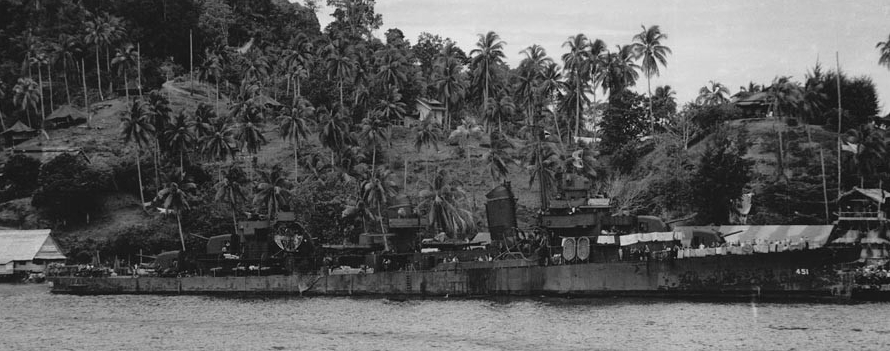
Strong received three battle stars for her service in World War II, recognizing her participation in the consolidation of the Solomon Islands (15-16 March, 12-13 May, 20 May and 16 June 1943), the New Georgia Rendova-Vangunu Occupation (4-5 July 1943), and for her destruction of RO-43 (7 April 1943).
Her name was struck from the Navy list on 15 July 1943.
| Commanding Officer | Date Assumed Command |
| Cmdr. Joseph H. Wellings | 7 August 1942 |
Jeremiah D. Foster
3 May 2018


